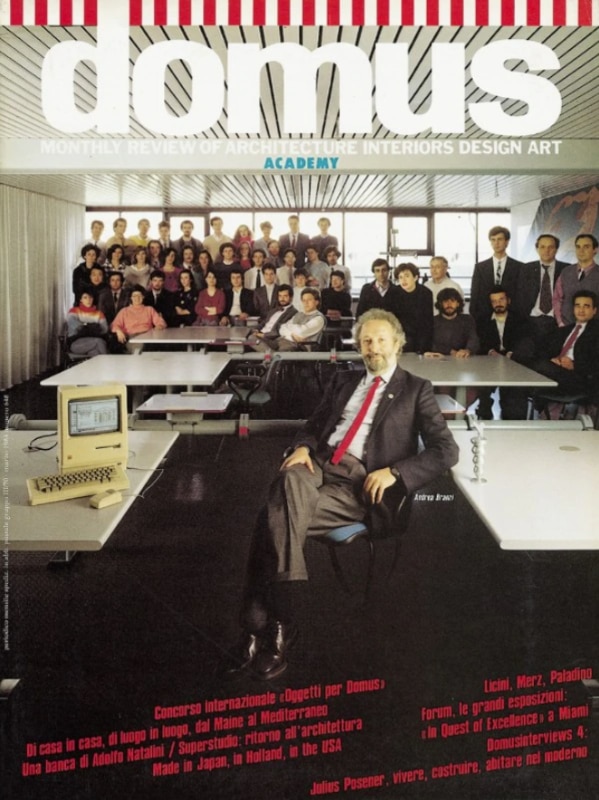Domus Academy 1983, Milanofiori, foundation year. It is early October and about forty young people, winners of a scholarship, meet to attend the first Master’s degree in design at the newly founded school. They have degrees in architecture, design or related disciplines and come from all over the world. Among the Italians there is Marco Romanelli. Born in Trieste (1958), educated in Liguria, he has just graduated in architecture in Genoa. The professors are extraordinary: Bellini, Branzi, Ferrè, Sottsass, Trini Castelli, but Restany and Meda too.
To talk about Marco Romanelli, I want to start from here, from the first day in Milan, from the memory of the emotion and curiosity of being catapulted into the global epicentre of design. A city that will become for most of us the city of adoption, where we can stay, if not forever, for a long time.
Marco goes through the stages of his profession quickly, with agility and naturalness. He has the openness of someone who was born and raised looking at the horizon, at the sea. An openness which, along with his deep knowledge of the history and culture of design, has led him to deal with the latter all-round. He is an eclectic professional who ranges from journalism and design criticism to curating exhibitions, books and catalogues, as much as interior and product design, consultancy for companies in the sector and university teaching.
His early years as an editor at Domus, directed by Mario Bellini, are followed by the years of Abitare and Inventario, up to the observatory of the Salone del Mobile.
Journalist and essayist, writing is easy for him, he has excellent writing skills. It is impossible to mention the many monographs dedicated to designers, exhibition catalogues and essays for publishers such as Abitare Segesta, Bellavite Editore, Corraini, D.E., Electa, Fam Publishing, Silvana Editoriale, Marsilio Editore and Skira.
The exhibitions are an opportunity for reflection and in-depth study, almost a loud dialogue between him and the users of design, accompanying him throughout his career: from the first sophisticated ones for the Jacqueline Vodoz and Bruno Danese Association to the latest intimate ones at the Diocesano and S. Eustorgio, to the important ones in international museums such as those on glass at the Correr in Venice and in Murano.
There are also exhibitions on Ponti in London, Rotterdam and at the Triennale, jewellery exhibitions, exhibitions on designers of all periods including Munari in Tokyo, Parisi and Frattini at the Royal Villa in Monza and the new generation of designers such as Damiani, Paruccini and Ulian at the Triennale and the Castle in Milan, and the history of Italian design for RCS at the Trajan’s Market in Rome, then become an itinerant exhibition. Curating requires study, method, cataloguing, analysis and has points of contact with the didactics that Marco Romanelli deals with by holding courses at the Polytechnic University and the IULM in Milan.

Nothing is difficult for him. Unpolitical, elegant, gentlemanly, a yesteryear upbringing, he is appreciated for his human as well as professional qualities. He had an “enveloping character, he made you feel good”, the designer Antonia Astori recalls, founder with her brother Enrico and Adelaide Acerbi of Driade, a company which Marco Romanelli is linked to by a collaboration for the Atlantide brand. He has had many other long-term relationships as an art director or design consultant: Oluce, Marazzi, Montina, Poltrona Frau.
But Romanelli is also the designer of many refined interiors, bourgeois houses, with a slightly but always cultured Pontian vision. A culture that represents for him a family tradition and therefore spontaneous and natural. With Marta Laudani, in a partnership that has lasted over the years, he has designed projects for many Italian companies.
It is difficult to say in which of the many fields he has been involved his contribution has been most incisive. Perhaps his ever-watchful criticism? Personally, I want to remember him with his sense of humour, never out of place, brilliant and disorientating. We both took part in a small book entitled Italianità, Edizioni Corraini, on symbolic objects of Italy, commissioned by Giulio Iacchetti. Marco’s text is undoubtedly the funniest of all. Figurine Panini tells of his childhood, school, his classmates, the exchange of “Got, Got, Need” stickers, and looks at the world and life with irony, intelligence, depth and a little regret.


